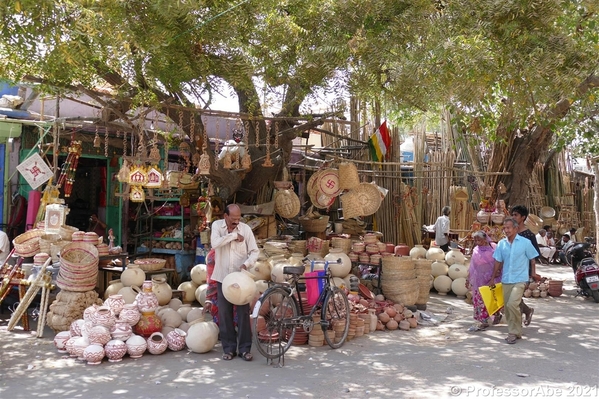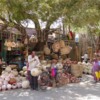Where Gumbo Was #425
This week's mystery location was Jodhpur, Rajasthan's second largest city - congratulations to PortMoresby, George G, Bob Cranwell and Roderick Simpson who guessed it correctly.
We visited Jodhpur, on the edge of the Thar desert, as part of an 18-day private car tour through India's North-West. Despite its size, it has a fairly laid-back atmosphere and Jodhpur's centre feels more like that of a provincial market town than the middle of a large city. The absence of tall buildings probably has something to do with that.
We thoroughly enjoyed just walking around the various market areas, taking in the sights, sounds, and smells (mostly emanating from food stalls).

The guy below is frying some more 'chilly bombs' - simply large chillies in batter, like those you see on the tray on the left. They are not as fiercely hot as the name suggests. In fact, I found them quite addictive.
The clock tower you can spot through the gateway below is the Ghanta Ghar, built during the reign of Maharaja Sardar Singh (between the late 19th and the early 20th century). The large trading area around this landmark is named after him.
The next photo shows the tower more clearly. The clock itself apparently was sourced from London.
From almost any point in the centre of Jodhpur you get glimpses of the huge Mehranghar Fort, which sits atop a 125m high rock overlooking the city.
The photo at the beginning of this piece also shows the fort. Below is another one taken from a different vantage point.
Whilst it is evident from these shots that the fort is large, you do not really appreciate just how big it is until you start approaching it from below.
On your way up you pass through several rings of imposing walls.
As you get higher, you start to get good views of the city below - and understand better why Jodhpur is often called the 'blue city'.
The fort's intimidating ramparts are in sharp contrast to the collection of palaces they protect. Most are elaborately decorated, both inside and out. The fort was originally erected in the 15th century, but most of the buildings you see today date from later periods.
Different rulers added bits and pieces to existing palaces or built completely new ones.
The differing styles are very apparent when you wander around inside the fort.
Some of the lavishly decorated rooms inside the palaces are open to the public.
The photo below shows the Throne Room in the Phool Mahal (Flower Palace).
The next shot depicts an exuberantly decorated room in the Takhat Mahal (named after Takhat Singh, a ruler in the mid-19th century).
Opulent decorations, incidentally, are not something that is confined to the 19th century - as these two photos of our hotel room illustrate.
Actually it wasn't just a room, but a sizeable suite, which we were given after complaining about the noise from a large and boisterous wedding celebration at the hotel. However, I am digressing ....
The photo at the very top was taken from another hill. The structures in the foreground are cenotaphs of some of Jodhpur's rulers and members of their families. They are part of a larger complex of memorials, the central one of which is the Jaswant Thada, a beautiful marble cenotaph built for Maharaja Jaswant Singh II (1838-95).
Several of the smaller cenotaphs at the complex are made of the same intricately carved marble (one of them featured as the first clue to the puzzle).
The site has a wonderful, peaceful setting by the side of a lake.
We got the impression that it does not generally see very many visitors. This guard at the main cenotaph certainly seemed surprised to find us walking through the door:
Below is a photo of its interior.
Our original plan had been that, following our visits to the Fort and the Jaswant Thada, we would spend the later part of the afternoon at another of Jodhpur's attractions, the Umaid Bhawan Palace (see photo below).
One part of this palace still serves as the residence of Jodhpur's (titular) royal family, but another section operates as a hotel and we thought it might be a good spot to have a pot of tea and perhaps a slice of cake. However, our guide advised us against it - apparently they only do a full British-style 'afternoon tea' and charge a small fortune for the privilege. We, therefore, decided to venture back into the central area of the city.
We didn't get our cake, but we found a nice quiet place that served decent tea (and did not charge exorbitant prices).
After an hour's rest we continued exploring. There is always plenty going on in the market districts of Indian towns and cities.
At the edge of the market area we came across this nicely preserved 'haveli' - the term used for a large mansion (typically built by wealthy merchants). This one now houses a boutique hotel.
It is next to an artificial lake, from which we caught our last glimpse of the Mehranghar Fort in the evening sun before heading back to the meeting point with our driver.
I remember that we had some doubt whether our driver - a very friendly and accommodating guy, whose English unfortunately was not exactly brilliant - had fully understood the arrangements we had tried to make. We were, therefore, greatly relieved when we found the car sitting at the exact location, with the driver standing next to it. I think he was just as relieved as we were when he spotted us.


Comments (1)